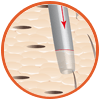Hair Transplant
HAIR TRANSPLANT SURGERY
Hair is the matter for concern for men and women both equally as it can make difference to their look and self esteem. People like their natural crowning glory so hair loss due to any reason like prolonged medical problem, genetic reason, hormonal problem, prolonged stress, can disturb them emotionally, socially and mentally too.
Fortunately, now it is possible to regain the younger and appealing look by restoring hair naturally and permanently with hair transplant procedure. Hair transplant is the aesthetic and most followed procedure to get the lifetime and safe results.
Our team of hair transplant experts is dedicated and determined to give most feasible results with the utmost satisfaction of patients which is received after meeting their expectations about their looks.
Our team is dedicated to bring 98.99% results for our patients.
QUICK EQUIRY
WHAT IS THE BASIC PRINCIPLE OF HAIR TRANSPLANT?
Basic principle of hair transplant is that hair follicles that are extracted from the Donor Area can grow naturally for lifetime after their shifting to the Recipient Area

Donor Area
Donor area is also called the permanent zone of scalp. It is the area in which loss resistant and most active follicles are present with sufficient density. Generally back head and area near to neck is considered as donor area from hair follicles are extracted.
Recipient Area
It is the area with no hair or less hair. It is loss affected area of the scalp that needs to be cover with required count of hair follicles with retained quality of loss resistance. Length and position of this area differ in different patients depending upon reason and extent of hair loss. Generally in males recipient area is the crown area in pattern hair loss.
TYPES OF HAIR TRANSPLANT?

FUE Hair Transplant
It is advanced method suitable for most of the hair loss patients. In this Follicular Unit Extraction hair follicles are individually selected and harvested from the wide spread donor area near to neck. It is result oriented and scar free method used for hair restoration and has quick healing after surgery.

FUT Hair Transplant
Follicular unit transplant is the traditional method in which hair grafts are extracted in grouping means in the form of strip from the back head. Strip of hair bear skin is dissected into natural grouping of hair and then these loss resistant grafts are transplanted in the recipient area according to requirement.
HAIR TRANSLANT BASIC PROCESS STEPS

1. Free Consultation
Patient can discuss beforehand with the experts about his hair loss problem, expectations, medical history to get the best advice for treatment.

2. Selection of Donor Area
In the digital scalp analysis hair follicles are examined to select the permanent zone for the extraction of best quality and loss resistant hair follicles.

3. Preparation of Donor Area
Donor area is washed with antibiotics to prevent infection and local anesthesia is applied to area to cause numbness in this zone.

4. Extraction of Hair Follicles
Hair follicles are harvested from the donor part carefully without damaging to the surrounding tissue and scalp in order to keep lock the quality and properties of donor follicles and reduce the scars.

5. Preparation of Recipient Area
Recipient area is made ready for transplantation after applying the local anesthesia so that patient can have comfortable and painless surgery.

6. Making Incisions
Tiny incisions are made in the bald areas in the irregular pattern that mimic the pattern of existing hair.

7. Transplantation
Grafts are placed into the small incisions carefully at proper angle and direction so that hair after growth looks natural and similar to the existing hair.

8. Winding Up Surgery
Surgery get over with the transplantation process and patient is asked to stay for some time in center and then can get back to home on the same day without any difficulty.
HOW TO ENSURE A VERY SAFE HAIR TRANSPLANT?

Hair Transplant Procedure at Satyam Hair Transplant Centre
Thinning hair or baldness can impact a person’s appearance and confidence. Countless people in the world face this problem. It is a common issue that happens due to age. As

Unlock the Secret to Stunning Hair at Satyam Hair Transplant Centre
Good looks are defined by good hair nowadays. Hair is an essential thing that impacts confidence. Everyone is scared of baldness and tries to keep the scalp healthy to prevent

FUT & FUE हेयर ट्रांसप्लांट में क्या अंतर है ? जाने दोनों में से कौन-सी सर्जरी है सबसे ज़्यादा उपयुक्त ?
हेयर ट्रांसप्लांट सिर के उस हिस्से पर बालों को जोड़ने के लिए किया जाता है जहाँ बाल काफी पतले हो जाते है या फिर गंजापन आना शुरू हो जाता है
